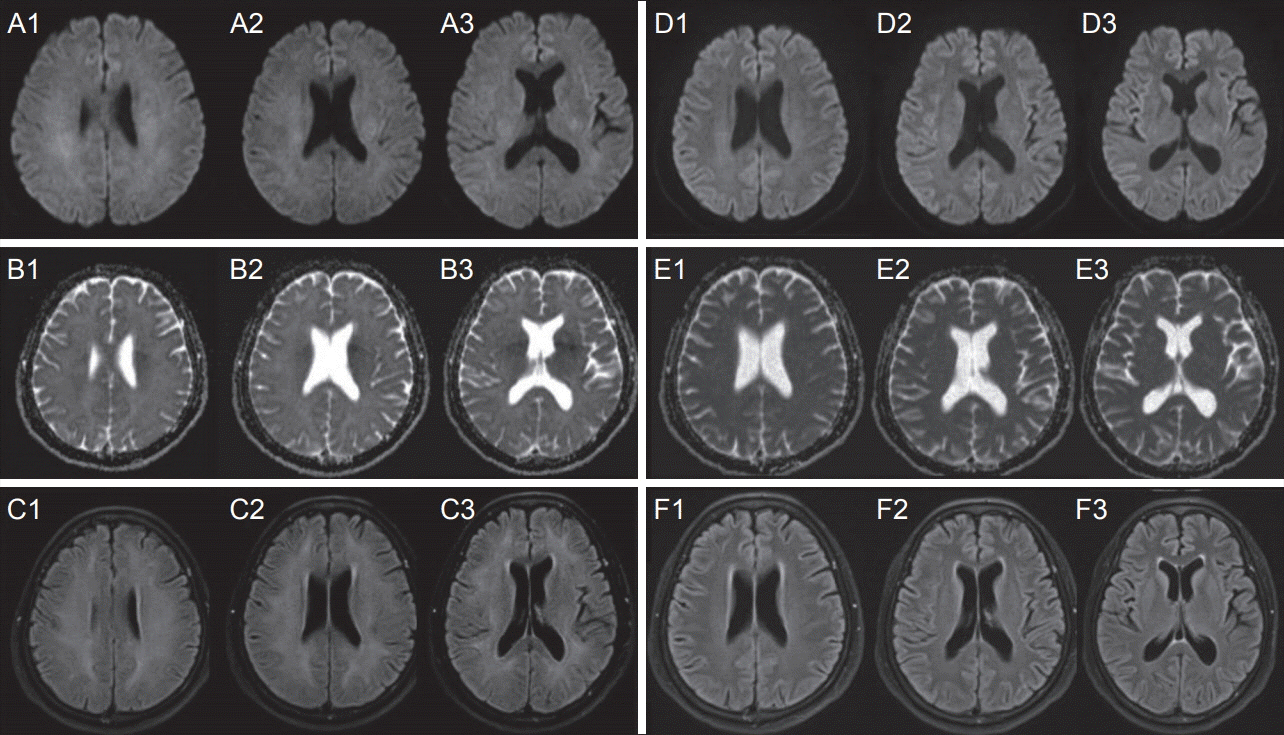A 57-year-old woman presented with sudden onset of transient dysarthria and dizziness. She underwent a mastectomy 10 years ago for breast cancer. She was healthy until this presentation and took no medication. A neurologic examination revealed dysarthria and mild postural tremor on both arms. Routine blood tests were within normal limits. Electrocardiography (EEG) showed no abnormalities. Both the brain MRI and MR angiography were unremarkable. The patient was diagnosis with transient ischemia attack and received aspirin and rosuvastatin. The initial thyroid function test was normal as T3 84.50 ng/dL (normal, 80-200 ng/dL), free T4 1.17 ng/dL (normal, 0.93-1.70 ng/dL), thyroid stimulating hormone (TSH) 8.53 μIU/mL (normal, 0.5-8.9 μIU/mL). Four days after admission, her speech became slower and she took more than 10 seconds to answer a simple question. However, the follow-up diffusion weighted imaging (DWI) was normal. We changed the medication from aspirin to cilostazol and clopidogrel. The EEG was repeated and showed bifrontal dominant slow waves and frequent sharp waves on the F
3/F
4 electrodes. We administered oxcarbazepine 450 mg/day and the antiplatelet agents and statins were withdrawn. On day 8, she developed intermittent aphasia and then had periods of brief confusion several times a day. The results of the language function test that was performed when aphasia occurred are as follows: naming was 0 of 6, fluency was 1 of 4, repetition was 1 of 4, comprehension was 1 of 4. We considered she had global aphasia and postictal confusion due to a complex partial seizure, i.e., ictal aphasia. We added levetiracetam 1,000 mg/day and phenytoin 300 mg/day. Eleven days after admission, her mental status had worsened; she was in a coma with intermittent whole-body myoclonus. On the follow-up EEG, there was an ictal discharge that started from the bifrontal area as a semi-rhythmic theta to delta wave at 4-6 Hz. We administered valproate 900 mg/day. On day 13, the follow-up MRI showed diffuse confluent high signal intensities on the bilateral cerebral white matter on DWI (A), apparent diffusion coefficient (ADC) mapping (B) and fluid-attenuated inversion recovery (FLAIR) images (C). We considered that the subtle high signal intensity on DWI was due to the T2 shiny effect, and the MRI findings were compatible with vasogenic edema (
Fig. 1). Cerebrospinal fluid analysis revealed a slightly increased level of protein, but other test results were unremarkable. The serum titers of anti-thyroglobulin (TG) antibody was increased as 1,175 IU/mL (normal, 0-115 IU/mL) and anti-thyroperoxidase (TPO) antibody was increased as 192.2 IU/mL (normal, 0-34 IU/mL). However, the level of TSH receptor antibody was normal as 1.63 IU/L (normal, 0-1.75 IU/L). The anti-neutrophil cytoplasmic antibody, anti-smooth muscle antibody, anti-nuclear antibody, and paraneoplastic antibody were all negative. Tumor screening tests were also negative. We diagnosed this patient as having HE and started intravenous methylprednisolone 1,000 mg/day for 5 days. On day 15, she was alert and oriented, and developed no further myoclonus or aphasic seizures. We started oral prednisolone 60 mg/day for maintenance. The EEG was normal. On day 22, the serum titers of anti-TG, anti-TPO, and TSH receptor antibody were decreased to 552.4 IU/mL, 129.8 IU/mL, and 1.02 IU/L, respectively. The result of the thyroid function test was normal. Thus she was discharged with oral prednisolone 10 mg per day. Four months after presentation, a follow-up MRI revealed the complete disappearance of the previous diffuse high signal intensities and she had no recurrence of symptom.
 | Figure 1.Brain MRI on day 13 (A-C) and four months after presentation (D-F). Axial DWI (A), ADC mapping (B) and FLAIR (C) images showing diffuse confluent high signal intensities on the bilateral cerebral white matter. Follow-up MRI (D-F) showing the disappearance of the previous abnormal signal intensities. MRI, magnetic resonance imaging; DWI, diffusion-weighted imaging; ADC, apparent diffusion coefficient; FLAIR, fluid-attenuated inversion recovery. 
|





 PDF
PDF Citation
Citation Print
Print


 XML Download
XML Download